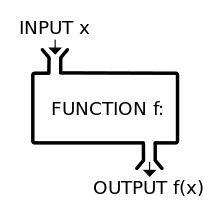Functions in Python: Difference between revisions
| Line 48: | Line 48: | ||
== Some decent videos about functions in Python == | == Some decent videos about functions in Python == | ||
In the video below, the programmer uses a different IDE than we do (we use canopy). | In the video below, the programmer uses a different IDE than we do (we use canopy). The programmer also uses [[tests]] in this video, which we haven't covered yet. | ||
<html> | <html> | ||
<iframe width="560" height="315" src="https://www.youtube.com/embed/Qa5DDqzHh3g" frameborder="0" allowfullscreen></iframe> | <iframe width="560" height="315" src="https://www.youtube.com/embed/Qa5DDqzHh3g" frameborder="0" allowfullscreen></iframe> | ||
Revision as of 20:09, 10 April 2016

A function f takes an input x, and returns a single output f(x). One metaphor describes the function as a "machine" or "black box" that for each input returns a corresponding output.[1]
Introduction
In programming, a named section of a program that performs a specific task. In this sense, a function is a type of procedure or routine. Some programming languages make a distinction between a function, which returns a value, and a procedure, which performs some operation but does not return a value.
Most programming languages come with a prewritten set of functions that are kept in a library. You can also write your own functions to perform specialized tasks. [2]
We use function so we don't need to repeat ourselves.
Example of a function
#
# this is a simple function
#
def welcome(name):
if name == "Alisher":
likes_hamburgers ="yes"
else:
likes_hamburgers="no"
return likes_hamburgers
print welcome("Bill")
print welcome("Alisher")
print welcome("foo")
Another classic example of a function
#
# this is a simple function
#
def calculator(number1, number2):
answer = number1 + number2
return answer
print calculator(12,43)
print calculator(91,673)
print calculator(1,3)
print calculator(87,1098)
Some decent videos about functions in Python
In the video below, the programmer uses a different IDE than we do (we use canopy). The programmer also uses tests in this video, which we haven't covered yet.